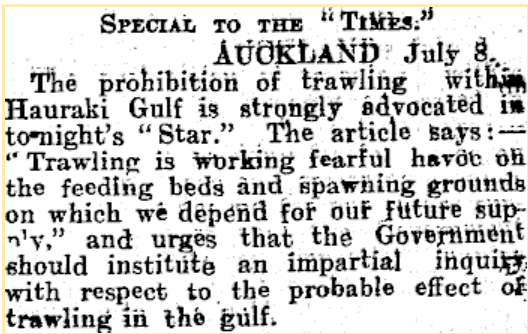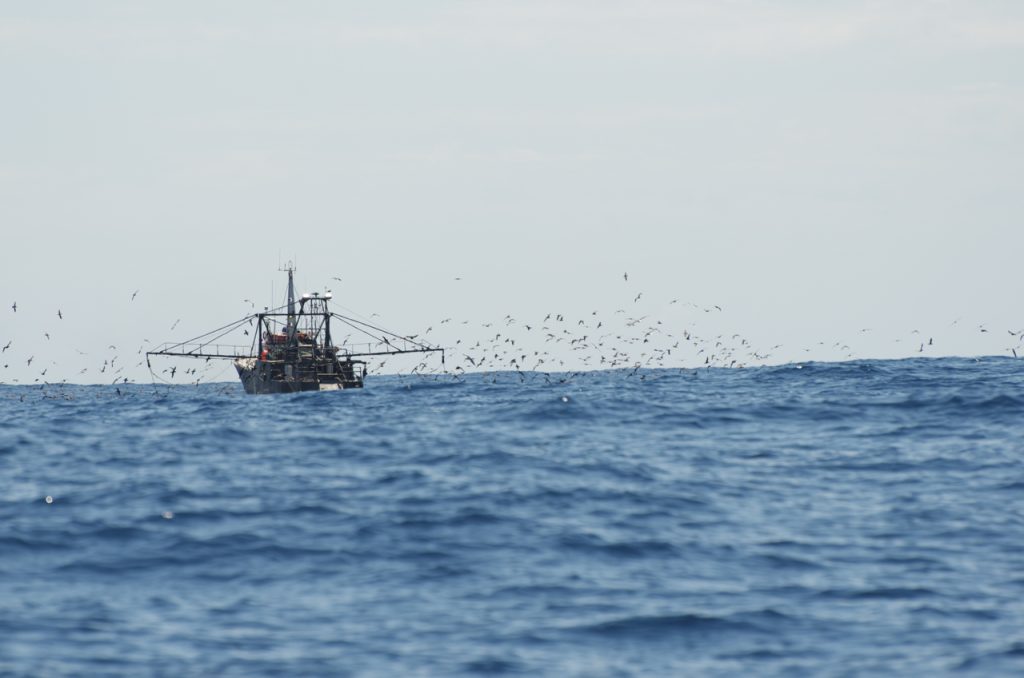
History of bottom trawling
in the Hauraki Gulf Marine Park
Bottom trawling in the Hauraki Gulf dates back over a century ago. Things were different back then – steam trawlers, smaller nets, and compared to now, vessels and equipment held less power and industrial force. As technology has developed over more recent decades, especially from the 1970s onwards, the limit of vessels and developments in trawl technologies has been pushed from unsustainable, to full-on raping and pillaging of our marine environment.
The first known exploration of trawling in the Gulf dates back to 1881 when a trawl net of unknown size was dropped between Tiritiri Matangi and Cape Colville.
In 1901, a steam trawler chartered by the Government set out to fish briefly in the Hauraki Gulf as part of an exploratory trawling survey of potential trawling grounds. It was reported that plenty of snapper were caught – an overall success.
Snapper was the key sought-after species from thereon in. In the 1920s, research into the impacts of what was then known as ‘power fishing’, consisting of trawling and Danish seining, of snapper was carried out – with not too much follow-up due to the depression and war that followed shortly after. Trawl net sizes were unrestricted for many years, and people worked hard and long days.

NEW ZEALAND TIMES, VOLUME LXXI, ISSUE 4403, 9 JULY 1901, PAGE 5


The hunt for snapper continued, and by the late 1940s, a steady decline in snapper numbers was commencing. By the 1960s, more research was being conducted into snapper and other Hauraki Gulf fisheries, such as tarakihi.
The 1970s saw the Hauraki Gulf snapper fishery at an all-time high. The commercial snapper fishery was booming, and Danish seine, bottom trawl, and pair trawl (with two trawl nets) were the dominant fishing methods. Overseas fishers from places such as Japan were well in the market, taking vast quantities of fish. By the 1980s, snapper catch in the Gulf was mostly by longlining as the Japanese “iki jime” market was developed. In 1982, the Hauraki Gulf became a controlled fishery and the first recreational bag limits were introduced in 1983.
From the late 1980s, the gulf snapper fishery was starting to show troubling signs of decline. Certain areas started to be prohibited to Danish Seine and bottom trawl from 1985 onwards. The Quota Management System was introduced in 1986, with promises to fix depleting fisheries. Fishers became reliant on good recruitment years as overall snapper populations were decreasing.
In the year 2000, bottom trawling was still the most used fishing method in the Hauraki Gulf, with 27% of landed fish and other species caught by bottom trawl.
Most bottom trawling nowadays occurs in the outer gulf, with species such as john dory, red gurnard, trevally, snapper, and tarakihi targeted. Some of these species, such as tarakihi, have very low numbers of fish left. In the Hauraki Gulf Marine Park today, around 17% of fish commercially caught is by bottom trawl methods.
A lot of work went into paving the way for bottom trawl usage in the gulf. To stop nets from being caught on habitats such as horse mussel beds, instruments such as steel wires, bobbins, and water-filled drums were towed to scrape mussels off their habitats to allow bottom trawling to occur in these areas. Area clearing of horse mussel beds, kelp forests, and other seafloor habitats to allow for trawling occurred all over the Gulf, from Little Barrier Island reefs, to around the Coromandel Peninsula.
Trawling for science is also still permitted in the Hauraki Gulf Marine Park, with bottom trawling occurring in a much bigger area than commercial fishing by bottom trawling is allowed. All of the outer gulf and many inshore areas use bottom trawling for research surveys, commissioned by Fisheries New Zealand.
Lots of fish populations in the Hauraki Gulf Marine Park are still declining, and although some are recovering slowly, such as snapper, they are not at population levels that are even half of what they were before bulk-harvesting industrial fishing methods, such as bottom trawling, were introduced. The introduction of these indiscriminate, destructive fishing methods is one of the main causes of fish numbers and seafloor habitat degradation around New Zealand. With fishing methods such as bottom trawling, Danish seining, and scallop dredging gone from the Marine Park, and our inshore waters, there is hope that our marine environment can recover for all to enjoy.
References
Fisheries (Auckland Commercial Fishing Restrictions) Notice 1985. S.7.j. (NZ).
Fisheries Assessment Plenary May 2008: Snapper. Fisheries New Zealand. https://fs.fish.govt.nz/Doc/5628/SNA_FINAL%2008.pdf.ashx
Hauraki Gulf Forum. (2010). Fishing the Gulf: Implementing the Hauraki Gulf Marine Park Act through Fisheries Management. ISBN: 978‐1‐877540‐79‐0.
Hauraki Gulf Forum. (2020). State of our Gulf 2020. State of the Environment Report 2020. https://gulfjournal.org.nz/wp-content/uploads/2020/02/State-of-our-Gulf-2020.pdf
Morrison, M. (2021). Hauraki Gulf Marine Park habitat restoration potential. New Zealand Aquatic Environment and Biodiversity Report No. 265.
Parsons, D., Sim-Smith, C., Cryer, M., Francis, M., Hartill, B., Jones, E., … Zeldis, J. (2014). Snapper (Chrysophrys auratus): a review of life history and key vulnerabilities in New Zealand. New Zealand Journal of Marine and Freshwater Research, 48(2), 256–283.
Let’s get trawling out of the gulf!
Want to do more to help?
Sign the petition
Thank you to the 36,000 people that signed the petition. It has been presented to Parliament for consideration.
Make a quick submission
Have your say now about trawl corridors in the Hauraki Gulf Marine Park. Choose Option Zero – 0% trawling!